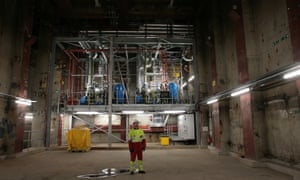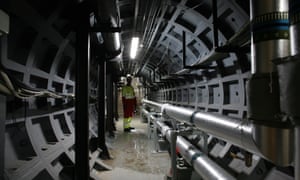
The underground power station, near Smithfield market, in central London.
Photograph: Martin Godwin for the Guardian
London’s hidden gas plant which could heat and power the future
A £26m refit of a power station beside Smithfield market has made E.ON’s Citigen the largest urban combined heat and power plant in the UK
The beautiful, listed facades of the Port of London Authority and the Central Cold Store, which once held animal carcasses from Smithfield market opposite, stand as a reminder of London’s industrial and commercial past.
But behind these brick walls in the heart of London is a hidden power station that could resolve how the UK heats, cools and powers business of the future.
The station, Citigen, has been owned and run by E.ON since 2002 but has been generating electricity since 1993, producing enough power for 11,300 homes and capturing the byproduct heat to send it off to buildings in the City of London via a network of tunnels. It also provides chilled water, which is used for cooling in several properties’ air conditioning systems.
There is no other combined heat and power plant of such scale in the centre of a UK city.
E.ON has just finished a three-year, £26m refurbishment that involved replacing the plant’s two unreliable and dirty ship engines with smaller, cleaner gas versions at the start of this year.
In the process, it has signed up new customers such as Blake Tower, a recently refurbished block of flats and Barts Square, a mixed residential-commercial development – the first new connections to the heat network for a decade.
John Armstrong, who heads E.ON’s decentralised energy unit, said: “The company previously didn’t necessarily know what to do with it [Citigen], but now we’ve invested heavily in it and recognise its importance in the heart of the city. The new connections show that there’s a demand for lower carbon heating and chill.”
The central location and listed buildings made the upgrade a challenge. The roof was taken off and a tower crane used to pluck out the enormous old engines and vast tank holding the 1m tonnes of diesel that powered them.
Above ground sits a new control room that now not only runs the power station beneath it but manages the 60 other district heating schemes that E.ON owns around the UK.

Wending your way deeper inside, across fragments of the building’s original tiling, are the rooms that house Citigen’s beating heart: the two gas engines, the equipment that recovers the engines’ heat and make the plant so efficient, the 50-metre tall thermal store (effectively a big hot water tank), and the chilling machines.
Water is heated to 105C-110C in the thermal store, before being piped out to the 17 connections served by the plant.
The facility produces three times as much heat as it does chill, but the demand for cooling is growing faster, said Armstrong. The fabric of historic buildings in the capital’s centre have been upgraded to retain much of their heat, but they were never designed for increasingly hot summers and are not good at keeping cool as the world warms.
From Smithfield, the network spiders out underground for 4 miles of heating and 2.7 miles of chill, taking in Guildhall to the south-east and the Barbican Centre to the east.
Around half of the pipes, made from steel and insulated with a foam doughnut around them, run through existing City of London tunnels, already crammed with power, communication and sewage pipes and cabling. The rest snakes through underground car parks, subways and basements.
In the basement of Blake Tower, the pipes connect to a heat substation, which takes up roughly the same space as around half a dozen parked bicycles. The compact nature of this kit and the space-saving it offers businesses is one of Citigen’s selling points in a part of the city where every square foot is at a premium.

But expansion and new connections are not always straightforward. While there are many existing tunnels, new digging and road closures are required too – sometimes at a cost of as much as £10,000 per metre in the capital.
Emily Lister, business development manager for Citigen, said: “The problem in London is that what seems like a short distance, in district heating terms is a very long distance. It’s very difficult because of the history of the city, it’s so congested.”
Such networks are niche in the UK today, especially compared to technology leaders such as Denmark and Sweden, but experts say they must expand if the UK is to meet its legally binding carbon targets.
While great strides have been made in cutting emissions from power – 50% of which is now low carbon – the much larger problem of decarbonising heat has barely been touched.
Heat networks such as Citigen at present supply around 2% of UK heating demand, but the government’s climate advisers believe that could reach 10% by 2030. As a result, the government is funding heat networks with £320m over five years.
“The last big challenge is heat,” said Armstrong. “You can electrify heat but that would require significant infrastructure investment. That’s where heat networks come in, as an alternative for how you provide carbon savings.”










